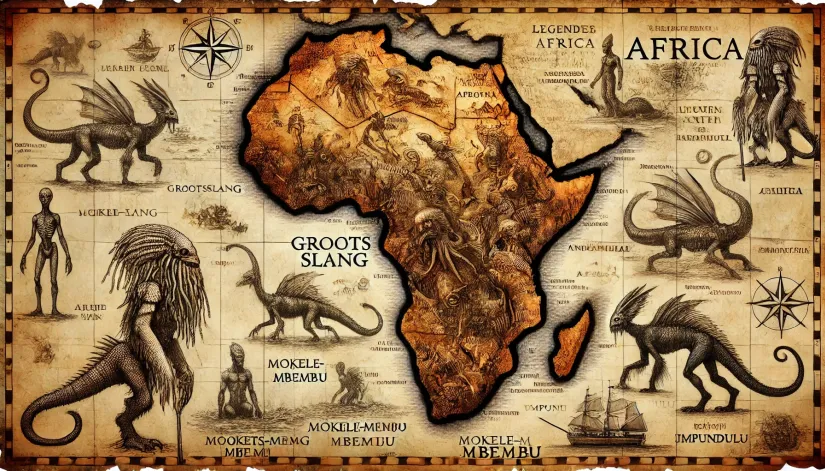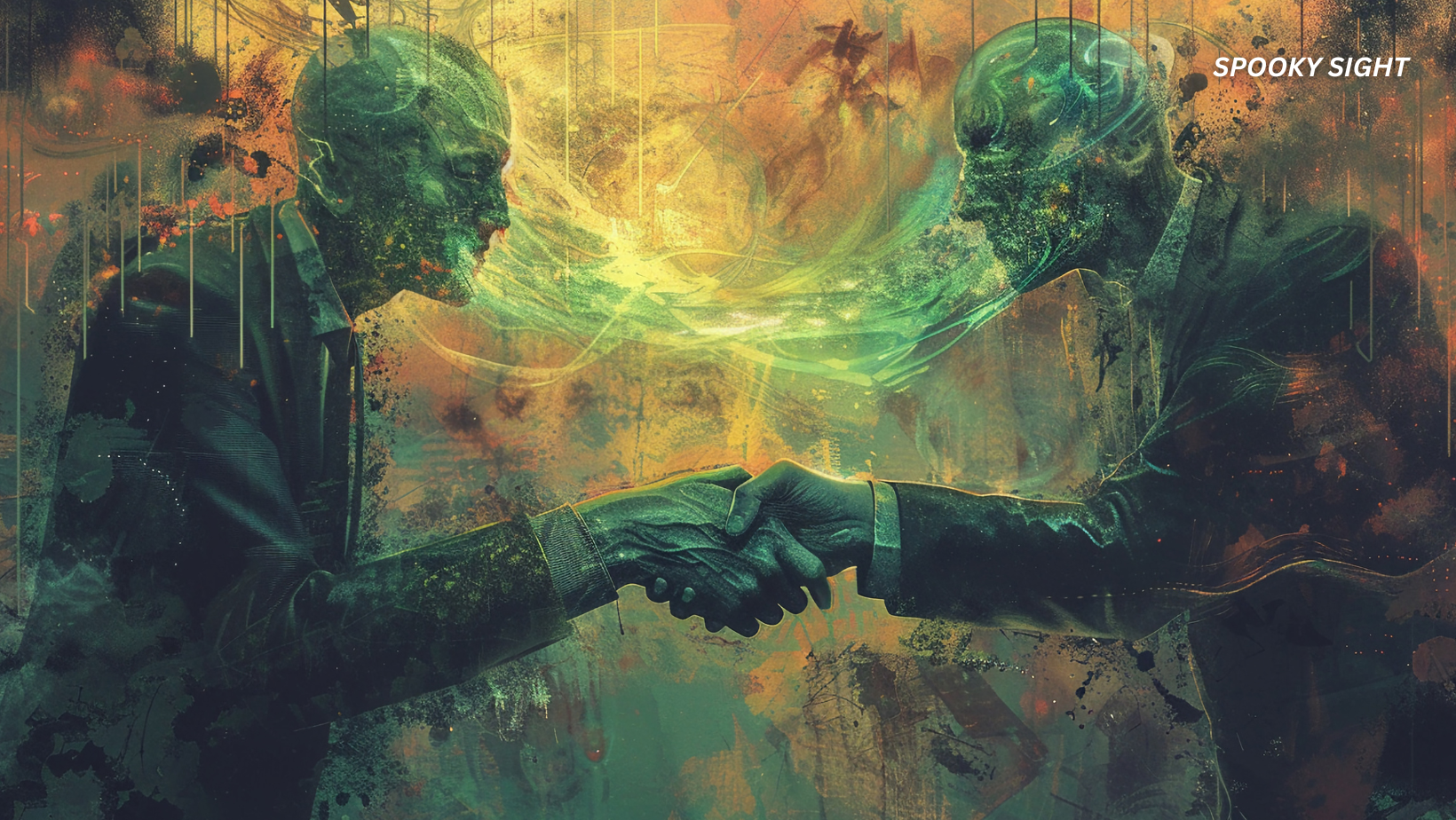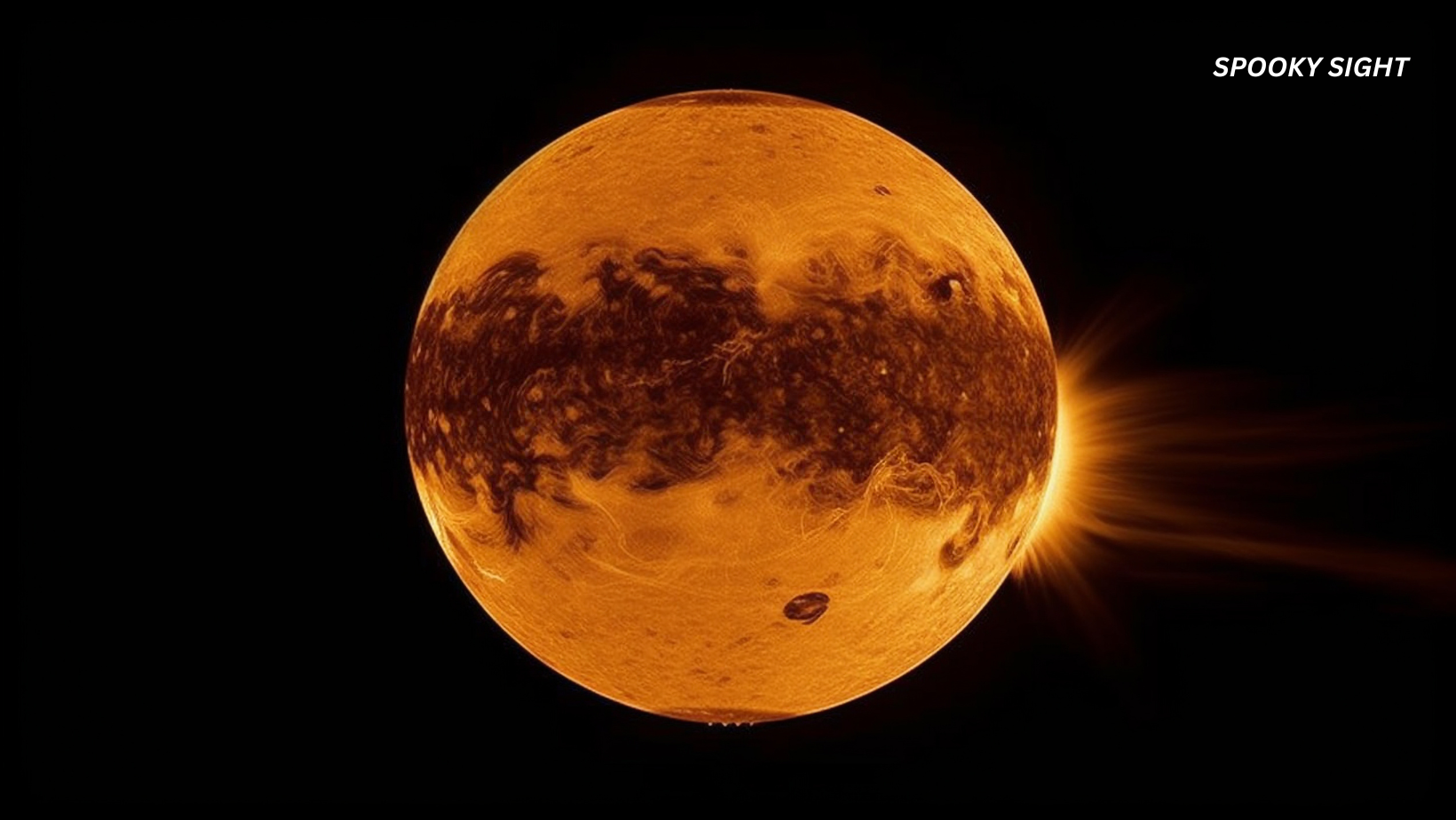Africa is rich in mysteries and legends. Its folklore is filled with rumors of elusive and enigmatic cryptids. From giant serpents to dinosaur-like beasts, these African cryptids have sparked curiosity and fear for generations.
In this article, we will explore the top 10 African cryptids. We will examine their origins, descriptions, and some of the most fascinating reports surrounding them.
Whether you’re a skeptic or a believer, these cryptids will surely captivate your imagination.
In this article:
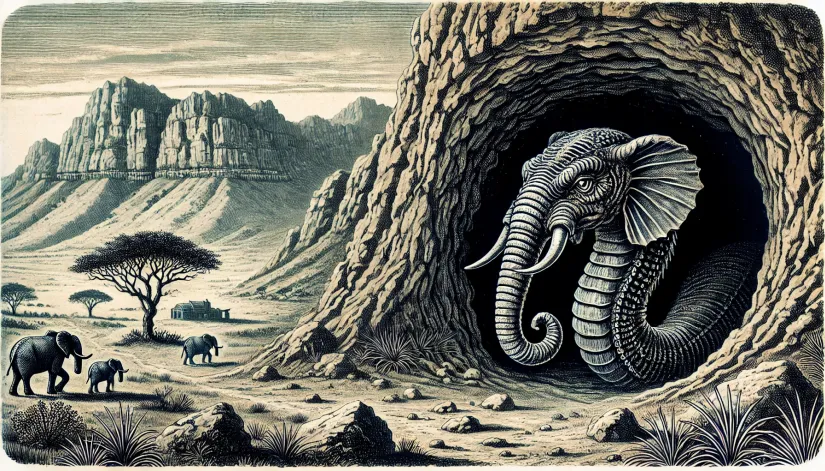
Grootslang: The Serpent of Richtersveld
| Feature | Description |
|---|---|
| Origin | South Africa |
| Description | Enormous serpent with elephant-like features |
| Habitat | Cave known as the “Wonder Hole” in Richtersveld |
| Behavior | Guards treasures, territorial |
| Abilities | Immense strength, cunning |
| First Reported Sightings | Early 20th century |
| Number of Reported Sightings | Dozens |
| Last Reported Sighting | 2020s |
| Notable Incidents | Reports by local miners and explorers |
Grootslang is one of the best-known African cryptids in South African folklore.
According to legends, the Grootslang is an enormous serpent with elephant-like features that possesses immense strength, cunning, and intelligence.
People in South Africa believe the Grootslang inhabits a deep cave (the “Wonder Hole”) in the Richtersveld region—a remote and rugged area that can provide the perfect hiding spot for such a mythical beast.
Who created such a fearsome beast? The gods, of course. According to some myths, the Grootslang was, in fact, one of the first creatures the African gods made.
However, its immense power and cunning nature forced the gods to separate its attributes into two different creatures: elephants and snakes. Yet, one (or more) Grootslang managed to escape this separation and has since been guarding vast treasures in its lair.
Grootslang sightings date back to 1917 when a diamond prospector reportedly encountered the creature in its cave.
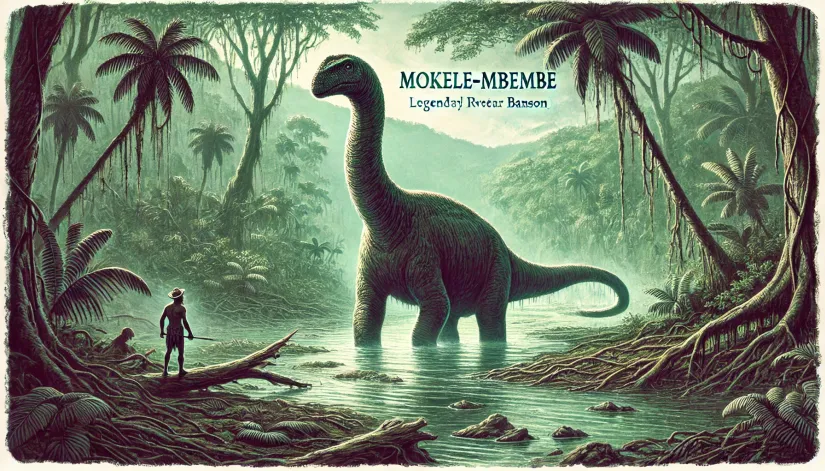
Mokele-Mbembe: Congo’s Last Living Dinosaur?
| Feature | Description |
|---|---|
| Origin | Congo River Basin |
| Description | Sauropod dinosaur-like creature with long neck and tail |
| Habitat | Rivers and swamps |
| Behavior | Herbivorous, extremely territorial |
| Abilities | Unknown |
| First Reported Sightings | 1776 (by French missionaries), detailed in 1909 (Carl Hagenbeck) |
| Number of Reported Sightings | Several dozen |
| Last Reported Sighting | 2000s |
| Notable Incidents | Expeditions by Roy Mackal in the 1980s |
Mokele-Mbembe (often translated as “one who stops the flow of rivers”) is perhaps the most famous African cryptid. Even today, many believe the creature inhabits the Congo River Basin—particularly in the Likouala swamps of the Republic of the Congo.
Descriptions of Mokele-Mbembe resemble a small sauropod dinosaur with a long neck, tail, and an elephant-sized body.
The first recorded sighting by Westerners dates back to 1776 when French missionaries in the Congo region heard local stories of a large, mysterious creature.
More detailed reports emerged in the early 20th century.
In 1909, a German explorer named Carl Hagenbeck mentioned the creature in his book “Beasts and Men,” recounting local tales of a creature resembling a brontosaurus.
As you can imagine, Hagenbeck’s fantastic narrative sparked significant interest, and many other expeditions followed. One notable expedition was led by American explorer Roy Mackal in the 1980s.
Mackal and his team collected multiple eyewitness accounts (mostly from local tribes) that described an enormous, long-necked animal inhabiting the region’s rivers and swamps.
However, Mackal failed to discover any concrete physical evidence of Mokele-Mbembe’s existence.
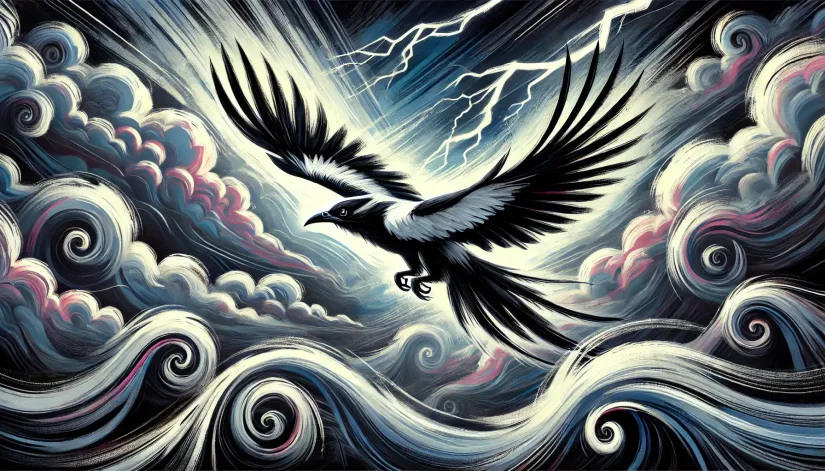
Impundulu: The Thunder-Summoning Vampire Bird
| Feature | Description |
|---|---|
| Origin | Xhosa and Zulu folklore |
| Description | Human-sized bird with black and white plumage |
| Habitat | Rural areas, near thunderstorms |
| Behavior | Vampiric, feeds on blood |
| Abilities | Summons thunder and lightning, transforms into a human |
| First Reported Sightings | Ancient folklore |
| Number of Reported Sightings | Unknown |
| Last Reported Sighting | Contemporary reports in rural areas |
| Notable Incidents | Folklore accounts and anecdotal stories |
The Impundulu is a fascinating African cryptid rooted in the folklore of the Xhosa and Zulu people of South Africa.
This vampiric bird is believed to possess the supernatural ability to summon thunder and lightning with its mighty wings. Described as a human-sized bird with striking black and white plumage, the Impundulu’s most terrifying trait is its thirst for blood.
Historically, the Impundulu has been a part of African folklore for centuries.
Its name (which can be translated as “lightning bird” in Zulu) reminisces its association with violent thunderstorms and the belief that it can control the weather.
Beyond its fearsome appearance, the Impundulu is also said to have the ability to transform into a beautiful human—often to seduce and lure its prey.
In many traditional stories, the Impundulu is often linked to witchcraft and is believed to serve as a familiar to witches, obeying their commands and attacking those who cross their masters.
Reports of sightings and encounters with the Impundulu are most common in rural areas—particularly in the Eastern Cape and KwaZulu-Natal regions—where belief in witchcraft and supernatural beings remains strong.
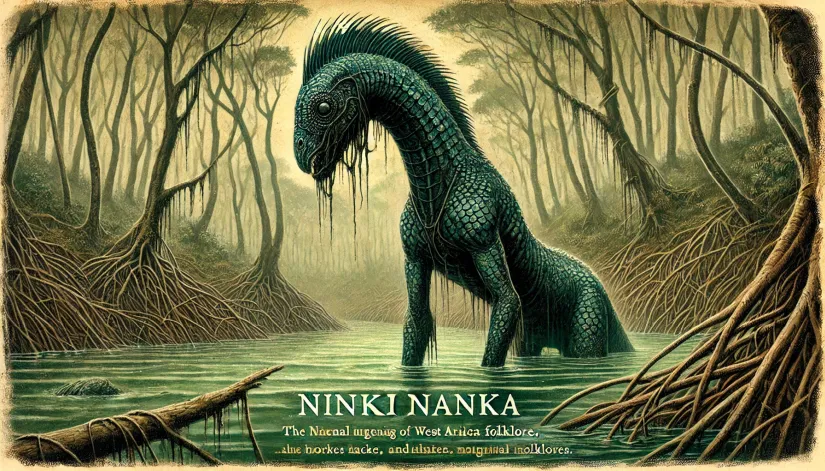
Ninki Nanka: The Swamp Monster of West Africa
| Feature | Description |
|---|---|
| Origin | Gambia |
| Description | Dragon-like creature with long neck, horse-like face |
| Habitat | Swamps of West Africa |
| Behavior | Shy, avoids humans |
| Abilities | Brings misfortune to those who see it |
| First Reported Sightings | 20th century |
| Number of Reported Sightings | Rare |
| Last Reported Sighting | 2000s |
| Notable Incidents | Fatal encounters reported by locals |
Originating from the Gambia, the Ninki Nanka is a legendary African cryptid some believe to inhabit the swamps and mangroves of West Africa.
Descriptions of the Ninki Nanka vary. However, it is commonly depicted as having a long neck, a horse-like face, and a reptilian body covered in scales.
According to some local legend, you will suffer fatal consequences if you are ever unlucky enough to encounter the Ninki Nanka.
The earliest reported sightings of the Ninki Nanka date back to the early 20th century.
One notable account from 1912 involved a British colonial official who claimed to have seen the creature while exploring the swamps.
Various expeditions have since been launched to find evidence of the Ninki Nanka—particularly in the River Gambia National Park and the wetlands of Senegal and Guinea-Bissau—but no conclusive proof has been found.
In 2006, the Centre for Fortean Zoology conducted an expedition in search of the Ninki Nanka, interviewing locals and gathering anecdotal evidence.
But again, they couldn’t find anything concrete to prove its existence.
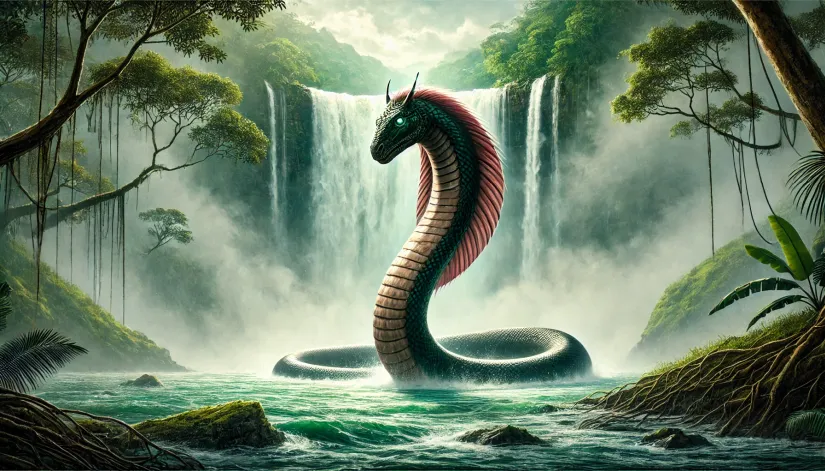
Inkanyamba: A Vengefull African Cryptid
| Feature | Description |
|---|---|
| Origin | South Africa, particularly Howick Falls |
| Description | Giant serpent with a horse-like head |
| Habitat | Pools and waterfalls |
| Behavior | Highly territorial |
| Abilities | Associated with violent storms |
| First Reported Sightings | Indigenous Zulu legends |
| Number of Reported Sightings | Numerous |
| Last Reported Sighting | 2010s |
| Notable Incidents | Sightings during storms |
The Inkanyamba is a terrifying serpent-like creature from South African folklore, particularly among the Zulu and Xhosa communities.
It is believed to inhabit deep pools and waterfalls, with the most famous sightings reported around Howick Falls in KwaZulu-Natal.
Described as having a horse-like head and an eel-like body, the Inkanyamba is often associated with violent storms and tornadoes and is believed to cause these natural phenomena when angered or disturbed.
Local legends suggest that the Inkanyamba can control the weather (somehow like Impundulu), leading to destructive storms during its migrations.
Reports of this African cryptid date back to ancient times, with cave paintings in the KwaZulu-Natal region depicting “rain animals” associated with intense summer storms.
Although some speculate that the Inkanyamba might be a large species of freshwater eel (such as Anguilla mossambica), the local belief in its supernatural abilities remains strong.
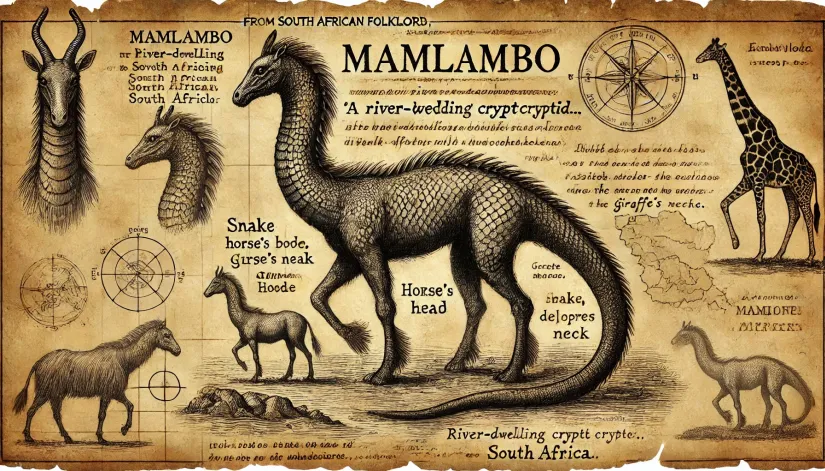
Mamlambo: The Terrifying Brain-Sucking River Monster
| Feature | Description |
|---|---|
| Origin | South African folklore |
| Description | Body of a snake, head of a horse, neck of a giraffe |
| Habitat | Rivers |
| Behavior | Drags victims underwater, consumes their brains |
| Abilities | Hypnotizes prey |
| First Reported Sightings | Ancient folklore |
| Number of Reported Sightings | Several |
| Last Reported Sighting | 1990s |
| Notable Incidents | Reported attacks on villagers |
Talking about terrifying African cryptids, here’s another one: the Mamlambo, or “Brain Sucker.”
This river-dwelling terror is typically depicted as having the body of a snake, a horse’s head, and a giraffe’s neck. Just the perfect nightmarish amalgamation to fuel local legends.
Unlike some other African cryptids and fantastic monsters—which typically prefer to avoid populated areas—the Mamlambo is infamous for its constant attack on villages.
He likes dragging his victims underwater and consuming their brains. This terrifying behavior has been reported in various communities along the Mzintlava River in the Eastern Cape province.
The legend of the Mamlambo dates back to the 19th century when the creature was feared and revered in equal measure.
The most notable surge of Mamlambo sightings occurred in 1997 in the village of Mount Ayliff, where local residents reported a series of attacks attributed to this monstrous cryptid.
Despite the widespread panic and numerous eyewitness reports, no physical evidence has ever been found to substantiate the existence of the Mamlambo.
Local authorities and cryptozoologists have investigated these claims but found nothing to prove the monster’s existence.
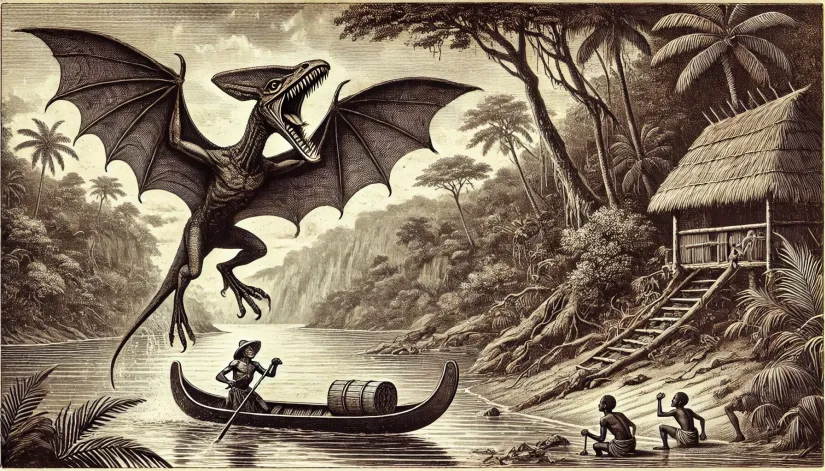
Kongamato: Africa’s Fearsome Pterosaur
| Feature | Description |
|---|---|
| Origin | Zambia, Angola, Congo |
| Description | Pterosaur-like creature with bat-like wings |
| Habitat | Swamps and rivers |
| Behavior | Aggressive, attacks boats |
| Abilities | Strong bite, flight |
| First Reported Sightings | Early 20th century |
| Number of Reported Sightings | Numerous |
| Last Reported Sighting | 2000s |
| Notable Incidents | Attacks on canoes |
The Kongamato (which translates to “overwhelmer of boats”) is another African cryptid reported in Zambia, Angola, and the Congo and is often described as a pterosaur-like creature with bat-like wings and a beak full of sharp teeth.
The Kongamato has an infamous reputation for attacking canoes and fishermen.
The first documented sightings date back to the early 20th century. Notably, in 1923, British explorer Frank H. Melland wrote about the Kongamato in his book “In Witchbound Africa.”
Melland recounted local tales describing the creature as a fearsome bird-like reptile with a 4—to 7-foot wingspan and reddish-black skin resembling that of a prehistoric pterosaur.
The local Kaonde people identified it from Melland’s picture of a pterodactyl.
Sightings continued into the mid-20th century, with a notable incident in 1956 when engineer J.P.F. Brown reported seeing two large flying creatures in Fort Rosebery (now Mansa), Zambia.
Brown described the creatures as having a long tail and a narrow head, with teeth visible in their open mouths, looking almost prehistoric.
In 1957, another sighting occurred when a man was admitted to a hospital in Fort Rosebery with severe wounds. He described being attacked by a large bird-like creature, and his sketch resembled a pterosaur.
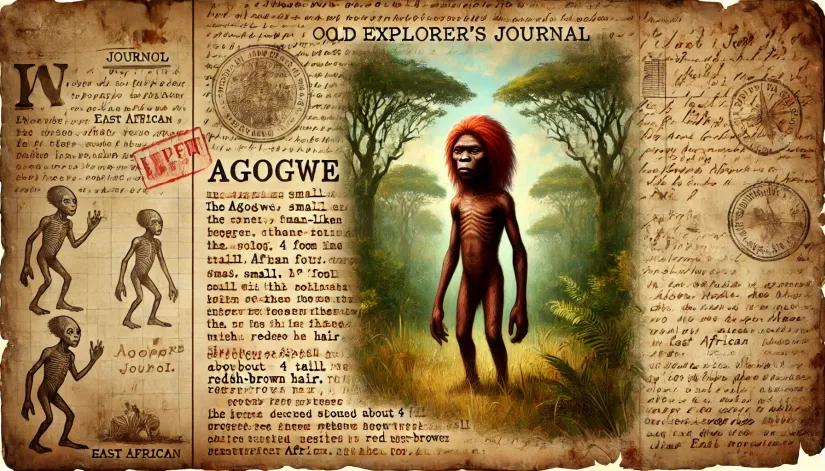
Agogwe: Forest Dwarfs of East Africa?
| Feature | Description |
|---|---|
| Origin | East Africa |
| Description | Small, human-like creature, about 4 feet tall |
| Habitat | Forests |
| Behavior | Shy, reclusive |
| Abilities | Elusive, hides well |
| First Reported Sightings | Early 20th century |
| Number of Reported Sightings | Few |
| Last Reported Sighting | 1980s |
| Notable Incidents | Brief sightings by explorers |
The Agogwe are small, human-like creatures reported in the forests of East Africa, particularly in Tanzania and Mozambique.
Described as standing about 4 feet tall with reddish-brown hair. Because of their physical characteristics, the Agogwe are often compared to the Bigfoot or Yeti.
Agogwe sightings date back to the early 20th century, with notable reports from European explorers such as Captain William Hichens in 1937.
Hichens reported seeing two small, brown, furry creatures while on a lion hunt in Tanzania’s Ussure and Simibit forests. He described them as walking upright, about four feet high, and covered in russet hair.
His account was published in the December 1937 edition of the journal “Discovery.”
Another notable sighting was reported by Cuthbert Burgoyne in 1927, who saw similar creatures on the coast of Portuguese East Africa (modern-day Mozambique).
However, despite various expeditions and numerous anecdotal accounts, no concrete evidence has been found to verify Agogwe’s existence.

Kasai Rex: A Living Tyrannosaurus?
| Feature | Description |
|---|---|
| Origin | Democratic Republic of the Congo |
| Description | Tyrannosaurus rex-like creature |
| Habitat | Forests and plains |
| Behavior | Predatory, attacks livestock |
| Abilities | Strong bite, immense size |
| First Reported Sightings | 1932 |
| Number of Reported Sightings | Few |
| Last Reported Sighting | 1950s |
| Notable Incidents | Reported attacks on wildlife |
The Kasai Rex is another well-known African cryptid from the Democratic Republic of the Congo, often described as a living dinosaur resembling a Tyrannosaurus rex.
The first alleged sighting occurred in 1932 when a Swedish plantation owner, John Johnson, claimed to have seen a large, bipedal predator attacking a rhinoceros near the Kasai Valley.
Johnson described the creature as reddish in color with blackish-colored stripes and a long snout filled with numerous teeth. He estimated it to be about 13 meters (approximately 43 feet) long and have thick legs built for speed.
Subsequent reports have described similar creatures preying on livestock and wildlife in the remote regions of the Congo Basin.
These reports often liken the Kasai Rex to large theropods (particularly Tyrannosaurus rex) though no concrete evidence of such a species existing in Africa during the time of these sightings has been found.
Instead, the Congo Basin was home to other large theropods (like Carcharodontosaurus) during the Cretaceous period.
Cryptozoologist Roy Mackal (known for his expeditions searching for Mokele-Mbembe) has also documented various reports and sightings related to the Kasai Rex.
However, despite numerous expeditions and anecdotal evidence such as footprints and supposed carcasses, definitive proof of the Kasai Rex’s existence remains elusive.
Photographs claimed to show the creature have repeatedly been debunked as hoaxes, including images showing what turned out to be statues or illustrations superimposed on pictures of natural environments.
One of the more infamous incidents involved a photograph taken by Robert Henderson, which showed a monitor lizard that some claimed to be the Kasai Rex.
The photograph has been scrutinized and largely discredited as evidence of this African cryptid.
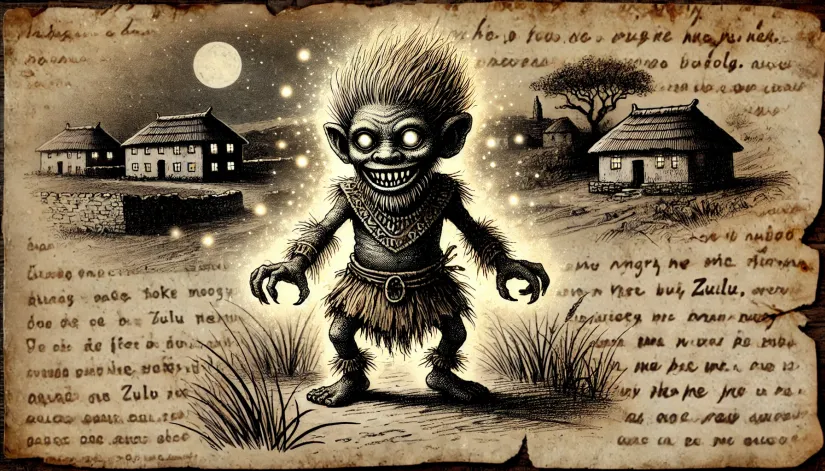
Tokoloshe: The Mischievous Magical Spirits
| Feature | Description |
|---|---|
| Origin | South African Zulu mythology |
| Description | Small, hairy dwarf-like creature |
| Habitat | Rural areas, near human settlements |
| Behavior | Mischievous, malevolent |
| Abilities | Invisibility, supernatural powers |
| First Reported Sightings | Ancient folklore |
| Number of Reported Sightings | Numerous |
| Last Reported Sighting | Contemporary reports |
| Notable Incidents | Alleged attacks and mischievous acts |
We conclude our list of top 10 strangest African cryptids with the Tokoloshe, a mischievous and often malevolent dwarf-like creature from Zulu mythology (but also known in various Bantu-speaking communities).
According to legend, sorcerers invoke the Tokoloshe to cause trouble or harm.
Described as a tiny, hairy humanoid with long claws, sharp teeth, and glowing eyes. Oh, and it has supernatural powers, too.
The Tokoloshe can stay invisible unless seen through a special spell or by children. It has the power to cause illness, nightmares, and even death.
While the Tokoloshe sightings are rare, people know exactly what measures to take to ward off the monster: elevating beds (by placing bricks or other objects under the legs of beds), sprinkling salt, using protective charms, or consulting a sangoma (Zulu witch doctor).

